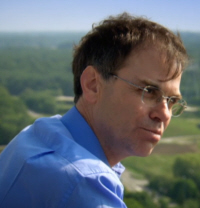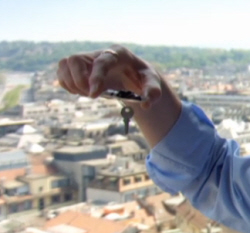Black Holes
spinons, orbitons & holons
Horizon - small Universe
ATLAS Building
Back at the LHC, far beyond the Higgs, smaller than the innards of a quark, Andy Parker now believes ATLAS could reveal something that, at this tiny scale,
shouldn't really exist.
Andy Parker "So this great big building here is at the top of the ATLAS pit. 100 metres straight down is the detector, that is operating at the moment, so we're
not allowed in the building for safety reasons."
He is hoping to make one of the most fearsome objects in the universe a black hole
a place where gravity is so vastly strong that nothing not even
light can escape.
It takes the entire mass of an imploding star, condensed into the space of a small town, to create the extreme gravitational pull of a black hole.
They are normally vast, and live at the centre of galaxies. And yet Andy Parker is trying to conjure up a micro black hole right here at CERN, using
just a couple of protons.
Andy Parker "It's perfectly possible that in the high-energy end of our data right now we are occasionally making miniature black holes. The protons
are colliding below us, they come together, they have a lot of energy in them. And gravity cares about energy. It's the same as mass as far as gravity
is concerned. So if you put a lot of energy in a small space, as we're doing right now, then you could potentially form a quantum-sized black hole.
A very, very tiny black hole. It wouldn't be stable, it wouldn't last a long time and eat the planet, it would disappear in a puff of radiation, and
we would see that puff of radiation in our detector."

Churxh Tower
The only way it would be possible to make these micro black holes, at least 20,000 times smaller than a proton, is if, on the level of the
really, really small, we discover that gravity is vastly stronger than it seems in everyday life. And that would change our view of the familiar
world, and challenge something we all take for granted that we live in a world of three-dimensional space.
Andy Parker "So this seems to be a perfectly ordinary three-dimensional world. There are three ways I can go. I can go forwards and backwards,
side to side, up and down. There can't be anything much more than that, can there? So if I want to go up in that tower, for example, over their,
I go sideways, I go forwards and I go up. Seems to be the only possibilities."

Andy Parker
But not necessarily. If we could conjure up an extra dimension, it could explain how you get super gravity at the tiny scale. Because, although
gravity seems strong in our everyday lives, it's actually pretty feeble.
Andy Parker "Gravity is a puzzle. It's very, very much weaker than the other forces actually a million, million, million times weaker than the
other forces. It feels strong plus right here, I'm feeling uncomfortable about gravity pulling me over the edge of this tower. But that's because
there's a whole planet there pulling me downwards."
The other forces that are hard at work holding the world together, including the electromagnetic force, are all vastly stronger than gravity.
Andy Parker "So here's a little magnet. And this key, being held down by all the atoms in the entire planet pulling towards the centre. And this
feeble little magnet can overcome the gravity of the whole planet quite easily. Now, why is gravity so weak? Well, one possible explanation is that
it's not actually weak. It's just as strong as the other forces, but we're missing part of it, and gravity is leaking into the extra dimensions,
and so when we calculate the strength of gravity, we're only seeing the piece that is in 3D."

Magnetism Overcoming Gravity
Most of our gravity could be leaking off into the fourth dimension. All we get is the leftovers. This would account for the feebleness
of gravity, but where could this fourth dimension be hiding?
Andy Parker "Well, if there is an extra dimension, it's everywhere. The question is, why can't we see it? All the others we can go off to
infinity along these directions but maybe the reason we can't see the fourth dimension is that it's actually curled up. If you went into it,
you go around in the little circle and come back on yourself, just like if you travelled on the surface of the Earth far enough, you'd come
back to where you started. But this would be on a very, very small scale."
Hiding an extra may mention may sound tricky, but it's all a matter of scale.
Flat Earth
Andy Parker "It's a very strange concept, but you can see it for people who live in a flat world. If we look down on the people down below,
then they're moving around on the surface, which is pretty much flat, and looked at from this large distance up, it just looks completely flat
and they move about, they cannot go up and down because they can't fly."
From a great height, the tiny people seem to live in two dimensions. But if we zoom into the same scale as the ant people, you realise they
can actually move up and down as well. Similarly, if we could get down to a small enough scale, we might find there is a fourth
dimension curled up. It may sound an outlandish theory, but if Andy spots his baby black holes, all this would be true.
Andy Parker "If we did see evidence of black holes at the LHC, that would be absolutely amazing because it tells us that everything we
think we know about gravity, general relativity and so on, isn't right. Then you would have demonstrated that the world is not three-dimensional,
but four-dimensional or more. And you would have made a black hole in the lab. So you get the Nobel prize for making a black hole in the lab, you
get the Nobel prize for proving general relativity wrong, and you get the Nobel Prize for demonstrating that the universe is multi-dimensional.
I mean, how cool is that?"


